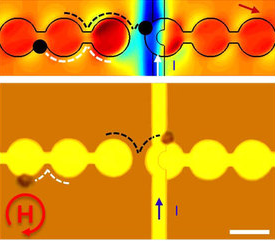JI Associate Professor Benjamin Yellen and his team have recently published a paper titled Magnetophoretic Circuits for Digital Control of Single Particles and Cells on Nature Communications, the prestigious American scientific journal.

Drawing inspiration from electronic devices, Prof. Yellen and his team have designed and developed matter circuit elements, which transport matters and individual cells instead of electrons. Furthermore, by combining these circuit elements, such as matter resistors, diodes, and transistors, they have developed a chip similar to a random access memory, which moves living cells rather than electrons. This design can be scaled up to store and release thousands of cells for further studies.
These magnetic circuits are fabricated on a magnetic thin film. Permalloy patterns as well as metallic current lines are formed on top of the substrate. By applying a rotating external magnetic field, the team has created an appropriate energy landscape to manipulate magnetic particles and cells.
After being sorted and stored, live cells can be studied individually. This is especially important in the case of rare cells which show special behavior. For example, in investigating cancer or HIV cells, they can be stored in separate apartments, and each cell can be analyzed for special behavior. This work can be applied to any biological particle.
Advised by Prof. Yellen, JI Ph.D. student Roozbeh Abedini-Nassab derived a semi-analytical code to simulate energy landscape as well as particle’s trajectory. His code speeds up the simulations. Using this code, the team can estimate particles’ trajectory, required currents, and geometries for each magnetic device to operate correctly. Moreover, with this code Roozbeh Abedini-Nassab created animations of energy distribution and particle’s trajectory. These videos were submitted to Nature Communications as part of supplementary materials.
This important paper resulted from the collaboration between Professor Benjamin Yellen and Professor CheolGi Kim from Korea. Both teams are continuing to work together to attain further achievements.
http://www.nature.com/ncomms/2014/140514/ncomms4846/full/ncomms4846.html
About Nature Communications
Nature Communications is a bimonthly peer-reviewed scientific journal published by the Nature Publishing Group since 2010. The online-only multidisciplinary journal is specifically designed to publish across all disciplines in the natural sciences, not only including all topics in physics, chemistry, earth sciences and biology, but also filling in gaps for research articles where there is no dedicated journal available in the Nature Publishing Group journals, such as developmental biology, plant sciences, microbiology, paleontology, and astronomy. Cross-disciplinary research such as biophysics, bioengineering, chemical physics, and environmental science are also published, as well as works from all individual disciplines.





